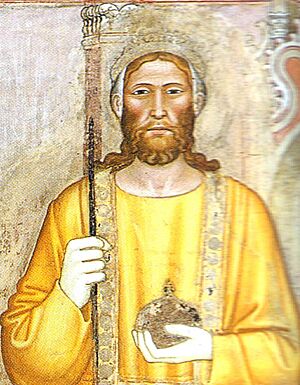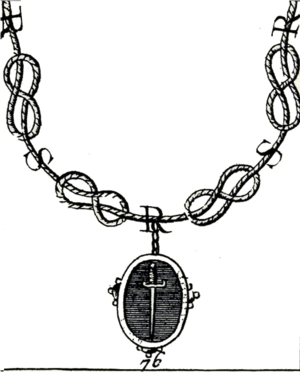Peter I of Cyprus facts for kids
Quick facts for kids Peter I |
|
|---|---|

Andrea di Bonaiuto: Peter I
|
|
| King of Cyprus | |
| Reign | 1358–1369 |
| Predecessor | Hugh IV |
| Successor | Peter II |
| Born | 9 October 1328 Nicosia, Cyprus |
| Died | 17 January 1369 (aged 40) Nicosia, Cyprus |
| Spouse | |
| Issue | Peter II of Cyprus Margaret of Lusignan |
| House | Poitiers-Lusignan |
| Father | Hugh IV |
| Mother | Alice d' Ibelin |
| Religion | Catholicism |
Peter I (born October 9, 1328 – died January 17, 1369) was a powerful king. He ruled as King of Cyprus and was also known as the "titular" King of Jerusalem. This means he claimed the title of King of Jerusalem, even though the city was not under his control. He became king after his father stepped down in 1358 and ruled until his death in 1369. Peter I was known for his military victories, but his plans were often stopped by disagreements within his own kingdom. Sadly, he was killed by three of his own knights.
Contents
Becoming King and Early Life
Peter was born in Nicosia, Cyprus, in 1328. He was the second son of Hugh IV of Cyprus. Hugh's first son, Guy, was supposed to become king. However, Guy died before his father. Guy's son, also named Hugh, wanted the throne. But Peter was chosen instead. He was crowned King of Cyprus on November 24, 1359, in Santa Sophia Cathedral in Nicosia.
In 1349, Peter and his brother John secretly traveled to Europe. Their father was very upset and sent ships to bring them back. When they returned, Peter and John were put in prison for leaving without permission. Some say Peter was held for two months and nine days.
Peter was also crowned as the "titular" King of Jerusalem on April 5, 1360. This happened in Saint Nicholas Cathedral in Famagusta. After the city of Acre fell in 1291, Cyprus became the last Christian stronghold in the Middle East. Peter believed it was his duty to fight against Islam and dreamed of taking back the Kingdom of Jerusalem.
His Marriages and Children
Peter married Eschiva de Montfort in 1342. She was the only daughter of Humphrey de Montfort, a high-ranking official in Cyprus. Eschiva died before 1350, when Peter was still young. They did not have any children.
In 1353, he married Eleanor of Aragon-Gandia. She became Queen of Cyprus in 1358 and Queen of Jerusalem in 1360.
Peter and Eleanor had three children:
- Peter II of Lusignan (around 1357–1382). He became king after his father.
- Margaret of Lusignan (around 1360 – around 1397). She married her cousin, James de Lusignan.
- Eschiva of Lusignan (died before 1369). She died when she was very young.
Since Peter II did not have any children, the crown of Cyprus later passed to Peter I's uncle, James I of Cyprus.
Fighting Against the Turks
Cyprus was the last Christian stronghold in the Near East. Neighboring Muslim powers, especially the growing Ottomans, were a big threat. Peter I decided to continue the tradition of the Crusades. He founded the Order of the Sword in 1347. This group of knights was dedicated to taking back Jerusalem.
Peter began his military actions by raiding Korikos. This was a fortified harbor in the Armenian Kingdom of Cilicia. In 1360, the people of Korikos asked Peter for help because the Turks were threatening their city. Peter sent his knights, and they successfully defended Korikos.
Muslim leaders in Asia Minor saw this as a threat. They formed an alliance and planned to attack Cyprus. They sailed many ships towards Cyprus. But Peter received help from the Knights of Saint John from Rhodes, the Pope, and even some pirates. In July 1361, Peter gathered a large fleet of 120 ships. He used this force to attack Asia Minor. On August 24, 1361, Peter conquered the city of Antalya after a short siege.
After this victory, the local Muslim rulers offered Peter a yearly payment. Peter accepted and had his flags and symbols raised in many cities in Asia Minor. He returned to Cyprus with his trophies on September 22, 1361. The former ruler of Antalya tried to take his city back with a large army. But the Cypriot forces managed to hold the city.
Traveling Through Europe
Peter had a problem with his nephew Hugh, who was still trying to claim the throne of Cyprus. Peter decided to visit the Pope himself to solve this. In late 1362, he traveled from Paphos to Rhodes and then to Venice. He was welcomed with honor. He met the Pope in Avignon and was officially recognized as the King of Cyprus. Hugh agreed to a yearly payment, and the problem was solved.
While in Europe, Peter tried to convince powerful rulers to join him in a new crusade. He wanted to free the Holy Land and the Kingdom of Jerusalem. He visited England, Germany, and France for this reason. He also visited important cities like Genoa, Venice, Prague, and Kraków. In Kraków, he took part in a meeting of kings and even won a royal Tournament (medieval).
However, Peter could not convince the European monarchs to join a large crusade in the Middle East. Meanwhile, his brother John governed Cyprus as vice-King. Cyprus faced many problems, including a deadly disease in 1363. This disease killed many people, including Peter's sister, Eschiva. The Turks heard about this and began new raids on the island.
The Alexandria Crusade
Peter's father had tried to stop him from leading a new crusade. But after his father died, Peter began his plans seriously. He traveled through Europe to gather support. On October 11, 1365, he led a mixed force of Cypriot and European Crusaders. They sailed on 70 ships to attack Alexandria in Egypt. This event is known as the Alexandrian Crusade.
However, the European knights refused to follow him to attack Cairo. So, Peter had to return to Cyprus. The only lasting result of this expedition was that the Sultan of Egypt became his enemy. The Pope advised Peter to make peace with the Sultan.
Attacks on Lebanon and Syria
Peter continued his crusades, next planning to attack Beirut. However, the Venetians offered him a lot of money not to attack Damascus. In January 1366, he raided Tripoli. He tried to gather another force in Europe in 1368, but he was not successful. The Pope again advised peace, and Peter had to join the Pope and the Venetians in trying to make a peace treaty with Egypt.
Trade with the Middle East was very good for Cyprus. Because of Peter, Famagusta became one of the richest cities in the Mediterranean. The Sultan of Egypt was still angry about the attack on Alexandria. He could not agree to a friendly peace with Peter. Peter's attack on Tripoli was a clear message to the Sultan: either make peace and trade, or face more attacks. The Sultan tried to distract Peter by strengthening the rulers in Asia Minor. He gathered an army to attack Korikos. But Peter sent more troops to Korikos, and they fought off the Turkish attack. In May 1367, the soldiers in Antalya revolted because they had not been paid. Peter sailed there and stopped the revolt, punishing those who started it.
Even though a peace treaty with the Sultan of Cairo was discussed, it was never signed. In late September 1367, Peter launched more attacks on the Syrian coast. He raided and took over Tripoli and other cities like Tartus and Baniyas. A storm stopped his forces from landing at Latakia. They then moved north to attack Ayas. On their way back to Cyprus, they raided Sidon and captured several merchant ships.
Finances and Death
Peter needed a lot of money for his trips around Europe and for his wars. Even though his kingdom had a good income, he needed more. So, he gave Cypriot serfs (people tied to the land) the right to buy their freedom. Many Cypriots benefited from this rule. Another way he got money was by raiding Islamic lands.
While in Rome, Peter received a request from the leaders of Armenia. They asked him to become their king and help their country. He returned to Cyprus, but soon faced problems at home. His wife, Queen Eleanor, had been unfaithful while he was away. Peter got angry and treated her favorite nobles badly, which also upset his brothers.
On January 17, 1369, Peter I was killed by three of his own knights. This happened in his bed at the Palace of La Cava in Nicosia. Despite his harshness, Peter was seen as a brave and chivalrous king because of his knightly adventures and his passion for crusades. He was buried in the church of St. Dominic's in Nicosia, where the Kings of Cyprus were traditionally buried. His son, Peter II, became the next king.
Images for kids
| Regnal titles | ||
|---|---|---|
| Preceded by Hugh IV |
King of Cyprus 1358–1369 |
Succeeded by Peter II |
| — TITULAR — King of Jerusalem 1358–1369 |
||




